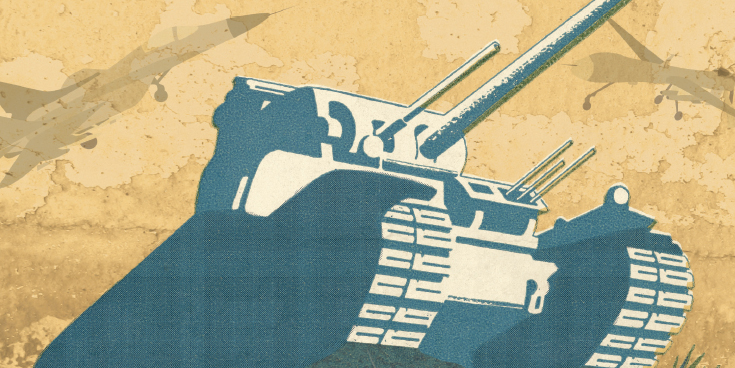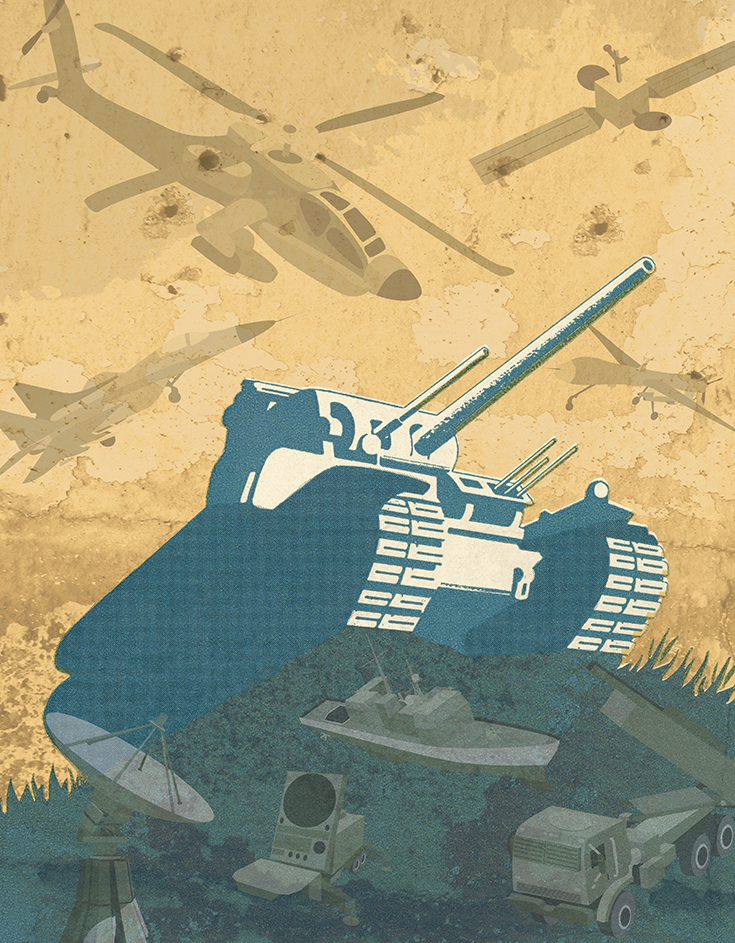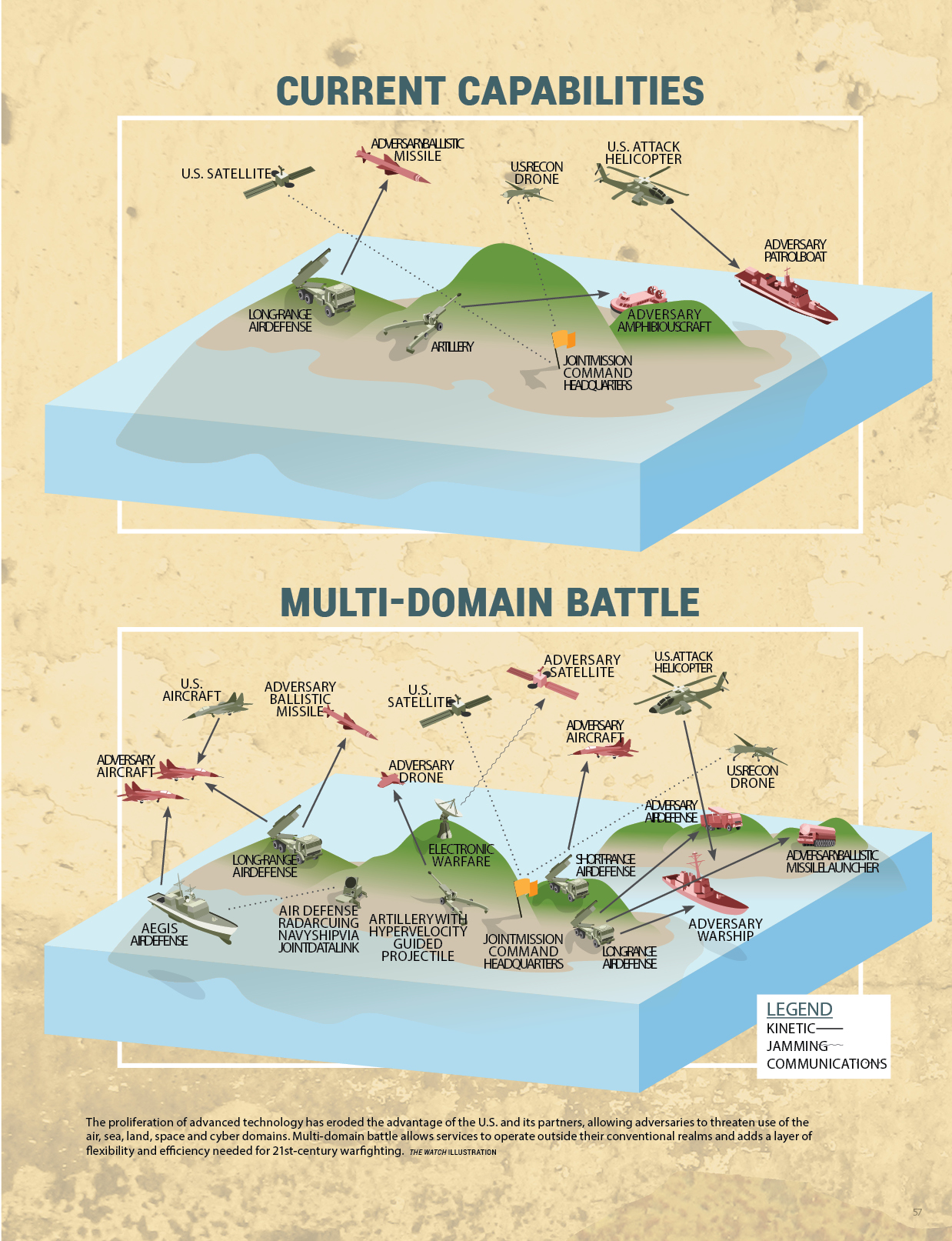Joint forces view multi-domain battle as key to future success
THE WATCH Staff
Global proliferation of advanced military technology has eroded to some degree the advantage the U.S. and its military partners have held for decades, allowing adversaries to threaten use of the air, sea, land, space and cyberspace domains.
U.S. commanders and their allies and partners, however, envision a different battlefield. It’s a battlefield where navies protect land forces and armies sink ships. It’s a battlefield concept that invokes every operating domain potentially all at once.
The name for this technological and philosophical leap into 21st century warfighting is called multi-domain battle, and commanders see this increased agility as key to success in complex environments.
“I’d like to see the Army’s land forces sink a ship, shoot down a missile and shoot down the aircraft that fired that missile,” said U.S. Navy Adm. Harry B. Harris Jr., then commander of U.S. Pacific Command (USPACOM). “Components must increase their agility and provide support to each other across the warfighting domains.”
Harris, who made the comments during the Association of the U.S. Army Institute of Land Warfare’s Land Forces of the Pacific Symposium and Exposition (LANPAC) in May 2017, said the U.S., its allies and partners and even individual service components need to be more comfortable working in a “complex environment where our joint and combined forces are operating in each other’s domains.”
Multi-Domain Battle Overview
The goal of multi-domain battle is to enable the services to more effectively integrate capabilities across the air, sea, land, space, and cyberspace domains to deter and if necessary defeat highly capable potential adversaries. Enemies are posing unconventional threats — threats from cyberspace, electronic warfare and even unmanned aerial vehicles and improvised explosive devices.
If the technology and different military command structures are integrated, however, the U.S. and its partners could regain the advantage, Harris said. Many service-specific technological systems present a challenge to doing so. The systems often don’t talk to each other, which hampers commanders’ abilities to deliver ordnance to targets in a timely fashion. The U.S. and its partners need to get “our alphabet soup of sensors and shooters talking to one another,” Harris said. “Ideally, we’ll get to a point where we’ll see the joint force as a network of sensors and shooters, allowing the best capability from any single service to provide cross-domain fires.”
That means the U.S. could detect a threat and Japan could eliminate it, or Australian sensors could detect a missile and relay the information to South Korea.

To test the concept, the U.S. Army of the Pacific (USARPAC) began sharpening these multi-domain capabilities with partners in the Indo-Pacific region at the Rim of the Pacific Exercise (RIMPAC) in 2018. RIMPAC is the world’s largest international maritime warfare exercise and is held biennially off the coast of Honolulu, Hawaii.
In 2016, 26 nations, more than 40 ships and submarines, 200 aircraft and 25,000 personnel participated. In 2018, to test the multi-domain battle concept, U.S. and Japanese ground forces fired shore-based missiles to subdue a threat at sea.
Gen. Toshiya Okabe, then chief of staff for the Japan Ground Self-Defense Force, said he looks forward to the day when the United States, Australia and other neighbors in the region implement the multi-domain battle concept. The interoperability it provides, he said, is essential to counter a potential adversary such as North Korea, which continues to defy United Nations sanctions related to its missile and nuclear weapons tests.
Multi-domain battle “must be very effective against North Korea,” Okabe said during LANPAC 2017. He also pointed out that trilateral cooperation and multi-
domain battle integration involving Japan, the Republic of Korea and the United States will be important to deter the secretive and bombastic North Korean regime.
“Ideally, we’ll get to a point where we’ll see the joint force as a network of sensors and shooters, allowing the best capability from any single service to provide cross-domain fires.”
U.S. Adm. Harry B. Harris Jr., thencommander of U.S. Pacific Command
Okabe pledged to provide security cooperation with Japan’s neighbors as well as the United States. “We will provide security cooperation to ASEAN [Association of Southeast Asian Nations] and to other countries in the region,” Okabe said.
One of the keys to making those partnerships a success is to reduce the predictability of military operations, said Gen. David G. Perkins, then commander of the U.S. Training and Doctrine Command. If a problem arises in a domain — for example, a hostile ship poses a threat to U.S. forces — historically, the U.S. Navy would have been asked to deal with it. “We tend to task that to the people who own it,” Perkins said. The problem that creates, however, is that “if you only go after it with that domain, the enemy knows that.”
Core Advantages
One of the key advantages of perfecting multi-domain battle is that it presents military leadership with multiple options to resolve a range of threats. It integrates the capabilities of different services and even militaries from other countries to defeat potential adversaries or rogue states, U.S. commanders say.
Not everyone has to bring skills from all domains to the table or invest financially to the degree that larger countries can, Perkins said. For example, one country might have a small Army but superior cyber skills, which could be used to allow joint forces to disrupt the military communications or navigation of an adversary.
One hypothetical example is a country that can defend its territorial waters, he added, but doesn’t have a “blue water” Navy to project power abroad. Perhaps that country’s contribution could be what the military calls A2AD, or anti-access/area denial. That country could defend its own territorial waters while agreeing to let the U.S. put military hardware in a militarily important geographic location to project power. “You don’t have to do it all,” Perkins said.
A2AD is a strategy that primarily uses land-based or shipborne cruise, ballistic and surface-to-air missiles to offset an opponent’s capabilities. They are used to attack an enemy’s critical ships, aircraft and ground sites. The progress that potential enemies have made across the globe in this arena have, in part, necessitated the move toward multi-domain battle and less predictable war plans, U.S. commanders say.
Regional Context
The rapidly growing economies, militaries and tensions in the Indo-Pacific necessitate the move toward a more sophisticated battle plan, wrote Gen. Robert B. Brown, commanding general of USARPAC, in an article on multi-domain battle.
The region contains 36 countries, more than half of the world’s population, three of the world’s largest economies and seven of the largest militaries. Dramatic technological shifts are occurring with unmanned vehicle capabilities, robotic learning, artificial intelligence and big data, which expand military competition between rivals, Brown said. Many of these new technological tools depend on the use of digital connectivity, making cyber defenses paramount.

Couple this with a region that is facing increasing security challenges, he said, and the need for multi-domain battle is obvious. The region wrestles with some of the world’s most intractable challenges. North Korea flouts United Nations sanctions with its increasingly capable missile technology. China challenges international norms by militarizing the South China Sea, and Russia is active in the region with an increasingly provocative military posture, he said.
“The most dangerous threat in the Indo-Pacific comes from regional actors with nuclear arsenals and the intent to undermine the international order,” Brown wrote. “Sophisticated denial capabilities and less-than-military forces managed by the state but backed by large militaries with interior lines of communication create the danger of faits accomplis.”
Risk Taking
Battling unpredictable enemies requires culture change. Implementing the multi-domain battle concept across the Navy, Army, Marine Corps and Air Force will require intensive training and a culture change from the highest levels of the military, Harris said.
Technological upgrades must be made so threat detection and weapons systems can talk to each other — both among U.S. services and potentially with partner nations. “The joint force must have faster, longer-range, more precise, more lethal and importantly, cost-effective and resource-informed solutions,” Harris said. “Not exquisite solutions that break the bank.”
Speaking of the culture change that will be required in a universe where military services operate their own budgets and technological systems, Harris said: “I look at our risk-averse culture and shake my head.”
Changing that culture, he said, demands a sustained effort. “We must incorporate this concept into the way we train year-round,” Harris said. “We all know that tomorrow’s fights are won during today’s training.”
The Army, in its description of multi-domain battle, acknowledged the cultural and technological changes required. “Adm. Harris has asked the Army to sink ships, neutralize satellites, shoot down missiles, deny enemy command and control forces and restrict maritime movement. To support that goal, the Joint Force must fully integrate their sensors and weapons systems more than before. Collectively, we must become sensor agnostic and shooter agnostic.”
Perkins said shared training and professional military education will be key in driving this interoperability between services and among friendly militaries. “When you train together, you work through problems,” Perkins said. “Plus, you build relationships.”
When discussing the more nimble and interoperable nature of tomorrow’s military, Harris likened it to ride-sharing companies such as Uber and Lyft, which provide apps detailing specific services. “Instead of ride sharing,” Harris said, “I’m looking for target sharing.”
With more sophisticated enemies, he added, the stakes are high. “Our country must maintain credible combat power in concert with like-minded allies and partners to preserve the unimpeded access to all the global commons,” Harris said. “Freedom, justice and a rules-based international order hang in the balance.”



